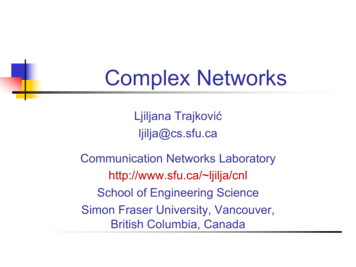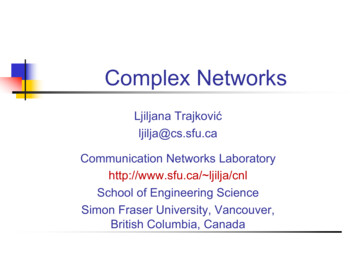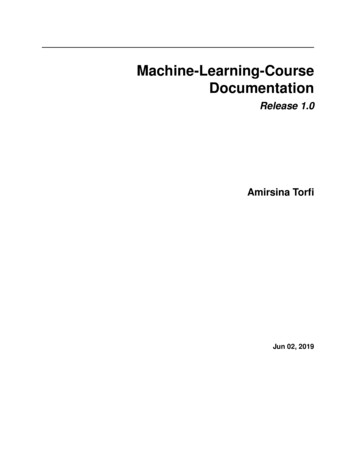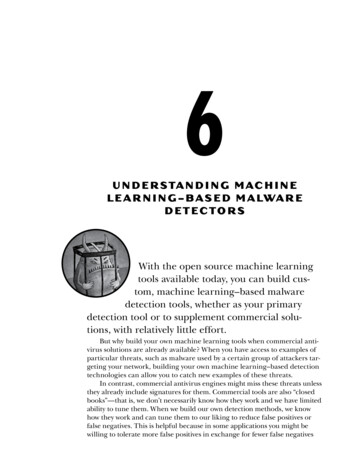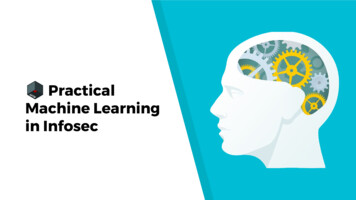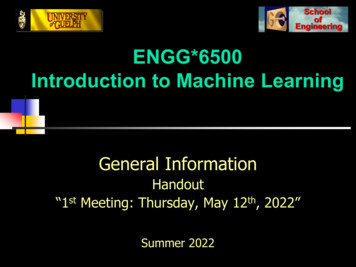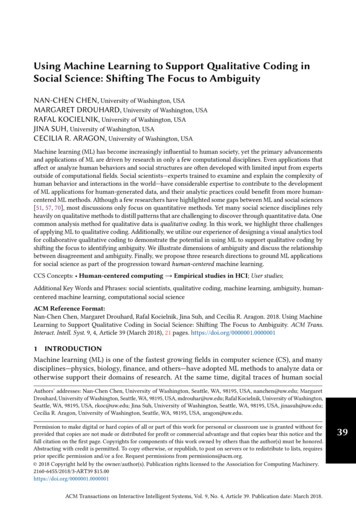
Transcription
Using Machine Learning to Support Qualitative Coding inSocial Science: Shifting The Focus to AmbiguityNAN-CHEN CHEN, University of Washington, USAMARGARET DROUHARD, University of Washington, USARAFAL KOCIELNIK, University of Washington, USAJINA SUH, University of Washington, USACECILIA R. ARAGON, University of Washington, USAMachine learning (ML) has become increasingly influential to human society, yet the primary advancementsand applications of ML are driven by research in only a few computational disciplines. Even applications thataffect or analyze human behaviors and social structures are often developed with limited input from expertsoutside of computational fields. Social scientists—experts trained to examine and explain the complexity ofhuman behavior and interactions in the world—have considerable expertise to contribute to the developmentof ML applications for human-generated data, and their analytic practices could benefit from more humancentered ML methods. Although a few researchers have highlighted some gaps between ML and social sciences[51, 57, 70], most discussions only focus on quantitative methods. Yet many social science disciplines relyheavily on qualitative methods to distill patterns that are challenging to discover through quantitative data. Onecommon analysis method for qualitative data is qualitative coding. In this work, we highlight three challengesof applying ML to qualitative coding. Additionally, we utilize our experience of designing a visual analytics toolfor collaborative qualitative coding to demonstrate the potential in using ML to support qualitative coding byshifting the focus to identifying ambiguity. We illustrate dimensions of ambiguity and discuss the relationshipbetween disagreement and ambiguity. Finally, we propose three research directions to ground ML applicationsfor social science as part of the progression toward human-centered machine learning.CCS Concepts: Human-centered computing Empirical studies in HCI; User studies;Additional Key Words and Phrases: social scientists, qualitative coding, machine learning, ambiguity, humancentered machine learning, computational social scienceACM Reference Format:Nan-Chen Chen, Margaret Drouhard, Rafal Kocielnik, Jina Suh, and Cecilia R. Aragon. 2018. Using MachineLearning to Support Qualitative Coding in Social Science: Shifting The Focus to Ambiguity. ACM Trans.Interact. Intell. Syst. 9, 4, Article 39 (March 2018), 21 pages. e learning (ML) is one of the fastest growing fields in computer science (CS), and manydisciplines—physics, biology, finance, and others—have adopted ML methods to analyze data orotherwise support their domains of research. At the same time, digital traces of human socialAuthors’ addresses: Nan-Chen Chen, University of Washington, Seattle, WA, 98195, USA, nanchen@uw.edu; MargaretDrouhard, University of Washington, Seattle, WA, 98195, USA, mdrouhar@uw.edu; Rafal Kocielnik, University of Washington,Seattle, WA, 98195, USA, rkoc@uw.edu; Jina Suh, University of Washington, Seattle, WA, 98195, USA, jinasuh@uw.edu;Cecilia R. Aragon, University of Washington, Seattle, WA, 98195, USA, aragon@uw.edu.Permission to make digital or hard copies of all or part of this work for personal or classroom use is granted without feeprovided that copies are not made or distributed for profit or commercial advantage and that copies bear this notice and thefull citation on the first page. Copyrights for components of this work owned by others than the author(s) must be honored.Abstracting with credit is permitted. To copy otherwise, or republish, to post on servers or to redistribute to lists, requiresprior specific permission and/or a fee. Request permissions from permissions@acm.org. 2018 Copyright held by the owner/author(s). Publication rights licensed to the Association for Computing Machinery.2160-6455/2018/3-ART39 15.00https://doi.org/0000001.0000001ACM Transactions on Interactive Intelligent Systems, Vol. 9, No. 4, Article 39. Publication date: March 2018.39
39:2Chen et al.interactions are proliferating, and increasing numbers of researchers in social science are workingto study human behaviors through social media and similar datasets (e.g., [59]). However, socialdata are complex and require detailed examinations. Researchers have pointed out that the limiteddata for minority populations may cause ML models to learn patterns or make inferences basedprimarily or exclusively on majority group traits, which can lead to exacerbation of stereotypes orunjust discrimination practices [3, 8, 11, 27, 32, 35, 45, 61, 69]. Therefore, it is important to carefullyintegrate ML methods with social science practice, and to draw from the expertise of trained socialscientists, in order to make claims about human behaviors.The field of computational social science has emerged to support analysis of ever larger datasets.Nevertheless, progress in applying computational methods like ML to social science research hasbeen relatively slow compared to fields like biology [38]. Furthermore, much of the work usingML techniques to make claims about human behavior derives from research in computationalfields such as computer science, statistics, and even physics, with limited involvement from socialscientists [13, 24, 69, 72]. Some researchers in computational social science are troubled by thisphenomenon because researchers with traditional computational backgrounds often lack trainingin social science methods and have limited experience examining complex social data [24].A number of existing discussions have tried to explain the gaps between social science and MLin computer science. One suggested difference is that data analysis in social science is theorydriven such that the data is drawn from a population with a presumed distribution (e.g., Poissondistribution, Gaussian distribution, multinomial distributions). On the contrary, classical machinelearning problems, such as image recognition, are usually data-driven such that the data is assumedto be drawn from an independent and identically distributed set where the goal is to find themost optimal model that fits the data. Computer scientists often design and tweak models directlyfrom raw data, independent of theoretical presumptions of data distributions [51, 57]. Althoughgreater attention to alignment with theory may account for some of the gaps in ML as quantitativeanalysis method for social science, other misalignments remain to be addressed. In fact, some socialscience analysis methods, such as grounded theory methods, start from no theory and constructtheories iteratively based on data. This type of qualitative analysis is commonly used in analyzingqualitative data, such as interview transcripts [4] and social media data [68]. Therefore, in order tobetter utilize ML for social science analysis, understanding the gaps between ML and qualitativemethods in social science is critical.In this paper, by leveraging our experiences of building a visual analytics tool for collaborativequalitative coding, we highlight a few intrinsic tensions between social science practice and machinelearning analysis in the context of qualitative coding. We then propose shifting the focus of MLpredictions to identify ambiguity. We conduct a Mechanical Turk study to understand different typesof ambiguity. Finally, we describe three future research directions and connect with existing work ineach direction. In highlighting these research opportunities, we intend to stimulate further researchtoward supporting social scientists’ use of ML for both quantitative and qualitative methods. Weanticipate that more human-centered, interpretable ML methods have the potential to transformsocial science research. Furthermore, findings from social science studies that use ML methodsmay bolster the theoretical foundations for ML applications built upon social data, in addition topromoting more human-centered, socially useful methods overall.2BACKGROUNDIn this section, we define the scope of the terms ‘ML’ and ‘social sciences’ in this paper. Then, weillustrate how ML is used in social science, followed by a summary of existing discussion on thegaps between ML and social science. Next, we provide a brief overview of qualitative methodsACM Transactions on Interactive Intelligent Systems, Vol. 9, No. 4, Article 39. Publication date: March 2018.
Shifting The Focus of ML for Qualitative Coding to Ambiguity39:3in social science, and specifically describe the process of qualitative coding and grounded theorymethods.2.1Definition of Machine Learning in This PaperML as a scientific field primarily focuses on developing algorithms and techniques to constructrepresentations (i.e., learn models) from data. Common topics in ML include supervised learning,unsupervised learning, and reinforcement learning. Supervised learning algorithms, such as supportvector machine (SVM) and decision tree, aim to build a model based on a labeled dataset (i.e., datawith ground truth labels) for predicting unlabeled or even unseen data. Unsupervised learningmethods, like k-means and hierarchical clustering, try to represent a dataset without ground truthlabels. Reinforcement learning works under dynamic environments where model construction isbased not only on data but also on feedback from the environment. Data mining is the scienceof extracting information from large, sometimes raw, data sets and can leverage techniques fromother disciplines such as statistics, ML, data management, pattern recognition, etc [26]. There arefour types of tasks within data mining. Exploratory data analysis is an interactive and iterativeprocess of exploring the data without any clear structure or goal (e.g., principal component analysis).Descriptive modeling is a way to describe or generate data (e.g., clustering, density estimation).Predictive modeling is a task that builds a model that predicts a variable given a set of other variablesextracted from data (e.g., classification, regression). Lastly, pattern recognition or detection is a wayto find regions in the space of data that differ from the rest (e.g., association rule learning). WhileML and data mining are easily conflated, it is important to remember that the goal of data miningis to support the task of understanding and discovering of unknown structures in a given datathrough the use of various techniques, and ML is one of many sources of methods that provides thetechnical basis for data mining [75]. In this paper, we use the term ML to refer to the techniquesused for modeling, exploration, and pattern recognition without necessarily connecting thesetechniques to how they are used in data mining.2.2Definition of Social Science in This PaperIn this paper, we refer to ‘social science’ as any discipline that studies human behaviors and socialphenomena. This definition includes traditional social science fields such as sociology, politicalscience, economics, anthropology, organization study, social psychology, etc. We also considermore recently emerged disciplines or research areas like computer-supported cooperative work(CSCW), social computing, and information science as social science since these fields partly inheritsocial science traditions and often rely on theories or methods from traditional social science fields.2.3Use of Machine Learning in Social Science2.3.1 Computational Methods in Social Science. Computational or statistical methods have beenwidely used in social science since Adolphe Quetelet (1749-1827), one of the most influential socialstatisticians and the inventor of the notion of the “average man," applied the principles and methodsof physical sciences to social sciences [46]. The study of social science events typically require sometype of basic descriptive statistics (e.g., central tendency, dispersion) and inferential statistics (e.g.,estimation of confidence interval, significance testing). Regression analysis (e.g., linear regression,analysis of variance) is used to model the relation between two or more variables for predictionand forecasting [50].ML methods, influenced heavily by statistics, have been gaining popularity in some social sciencedisciplines [63] and are used for predictive and descriptive analysis of data. With computationaland ML methods, social scientists can process and distill large amounts of data with numerousACM Transactions on Interactive Intelligent Systems, Vol. 9, No. 4, Article 39. Publication date: March 2018.
39:4Chen et al.variables to infer causality or relations among latent variables or to predict outcomes for unseendata.Dimensionality reduction techniques (e.g., factor analysis, principal component analysis) caninfer the relations between latent structures [74]. Structural equation modeling is a techniquethat allows development of a new variable from an existing set of variables [7]. Latent dirichletallocation is a generative probabilistic modeling technique used for topic modeling that reducesthe data to a probability distribution of “latent" topics discovered within the data [5]. K-meansclustering, although published more than 60 years ago, is still widely used among ML practitionersand social scientists to separate large data space into subspaces that are manageable and meaningful[33].2.3.2 Bridging the Gap between Machine Learning and Social Science. Although ML methodsused in computational social science share the same foundations as statistical methods used intraditional social science, some ML researchers in computational social science have indicated thatthere are several fundamental conflicts between ML and social science [51, 57, 70]. For example,the goal of ML is to predict behavior on unobserved data (A changes with B when everything elseis held constant, or correlation), whereas the goal of social science is to understand and explainthe whys and hows of observed phenomena (A influences B when all else is equal, or causation).While causality has been a fundamental concern in social science, ML has traditionally not focusedon causality. Instead, ML puts emphasis on fine-tuning models and parameters to achieve highprediction accuracy, or other metrics like precision and recall. Settles suggested that social scienceis deductive and hypothesis-driven, while machine learning is inductive and data-driven [57].Similarly, Rudin highlighted that a social scientist may form a hypothesis first and collect the dataspecifically curated to test the hypothesis. A ML scientist will collect a large set of data with fewpre-defined goals and usually assume that the data is independent and identically distributed [51].In addition, in a recent book chapter, Wallach pointed out several differences between social scienceand computational social science in computer science [70]. For instance, social scientists usuallymake claims based on multiple sources of information. However, most modern ML algorithmsonly work under single-source settings. Thus, directly applying such a method to social scienceproblems is challenging. Furthermore, many ML methods are concerned merely about feasibilityand efficiency of the model. Results with only efficiency concerns without taking interpretabilityor accountability into account can be risky for making social science claims.With increasing demand and interest in computational social science, many efforts have beenmade to bridge the gap between ML and social science. There has been a shift in focus to reframe MLin causal inference in order to discover natural experiments hidden in large data or to use machinelearning to predict counterfactual relations [2, 55, 66]. Some recent computational social scienceresearch places strong focus on the explanation of phenomena (why and how), and while researchon single data source is still prevalent, there have been discussions on potential computationalchallenges and opportunities to go beyond a single data source in order to answer meaningfulsocial science questions [70]. Wallach suggests several ways for computer scientists and socialscientists to collaborate and to advance computational social science: (1) understand each other byengaging in meaningful discussions and attending each other’s conferences, (2) create high-qualitypublication venues for interdisciplinary work, and (3) create interdisciplinary degree programs totrain the next generation of computational social scientists [70].2.4Qualitative Methods in Social Science and Qualitative CodingIn addition to quantitative methods (e.g., statistical, computational,ML), social scientists use qualitative methods, such as observation, interviews, and case studies, as their primary research meansACM Transactions on Interactive Intelligent Systems, Vol. 9, No. 4, Article 39. Publication date: March 2018.
Shifting The Focus of ML for Qualitative Coding to Ambiguity39:5or mixed with other quantitative methods. Qualitative methods have a long history in the humanities. Since the early 20th century, fields like anthropology and sociology have establishedthe importance of qualitative inquiry [18]. For instance, a common approach to collect data inanthropology is ethnography. In ethnographic studies, anthropologists go into a foreign society(called a field site) for a long period of time and use a set of qualitative methods to collect data forunderstanding the culture of the society: researchers observe people and their interactions on thesite, and interview people to collect their explanations of their behaviors. In the digital era, suchan ethnographic approach is often deployed to study people’s cyber behaviors and online socialphenomena. Researchers can go on a virtual site to observe users’ posting behaviors or collect a setof historical posts to distill interaction patterns.A common way to analyze qualitative data is qualitative coding. Qualitative coding, or simplycoding, is one of the major techniques used in qualitative analysis among social scientists [60].In general, coding refers to the process of assigning descriptive or inferential labels to chunksof data, which may assist concept or theory development [42, 44, 64]. Coding is usually a verylabor-intensive and time-consuming task [60, 77]. It requires researchers to examine their datain detail, find relevant or potential points of interest, and assign labels. As the size of datasetsgrows significantly in the era of big data, manually coding the entire dataset in detail is notfeasible for social scientists. As a result, social scientists can only sample and code a small partof their data. Since a large portion will remain under-explored, researchers may not be able toresolve inconsistencies in their theories and may not even recognize if some analysis is missing orincomplete.2.4.1 The need for qualitative coding. Coding is a process of arranging qualitative data in asystematic order by segregating, grouping and linking it in order to facilitate formulation of meaningand explanation. Such analysis is often used to search for patterns in the data by organizing andgrouping similarly coded data into categories based on commonly shared characteristics [53]. Eventhough some qualitative data—such as tweets—have metadata, organizing data based on thesemetadata is often not enough to achieve researchers’ analysis goals. Thus, coding is necessary forresearchers to create structure and impose it on the data to determine how best to organize theinformation and facilitate its interpretation for their purposes [39].2.4.2 Grounded Theory. Grounded theory (GT) is one of the most well-known set of approachesto deal with code organization and theory development. As Charmaz articulated in one of the mostreferenced GT textbooks [12], “grounded theory methods consist of systematic, yet flexible guidelines for collecting and analyzing qualitative data to construct theories from the data themselves.”It is important to note that this broad definition encompasses a number of GT approaches suchas classical Glaserian GT [23] and Strauss’s approach [29]. Here we describe the steps involvedin one of the most recent variations of GT, called a constructionist GT as presented in Charmaz’sintroduction to grounded theory [12]. Despite differences, other GT approaches share a majority ofthe steps described here.Analysis steps under GT are not carried out sequentially since insights or realizations of analyticconnections can happen any time during the research process [12]. In GT, coding provides ananalytic skeleton and links connecting data with developing emergent theory. The analysis startswith an initial line-by-line, unrestricted coding of the data termed open coding. The aim is to produceconcepts that seem to fit the data. The line-by-line focus is meant to prompt studying the dataclosely and trigger conceptualizing emerging ideas. At this stage, codes are entirely provisionaland prone to change.The second step is focused coding in which a researcher works with initial codes that indicateanalytic significance. This permits for separation, sorting and synthesizing large amounts of dataACM Transactions on Interactive Intelligent Systems, Vol. 9, No. 4, Article 39. Publication date: March 2018.
39:6Chen et al.and also accelerates the analytic pace [62]. While performing focused coding, it is also possibleto engage in an optional step of axial coding, which involves coding dimensions of a categoryand exploring the relationship between that category and other categories and subcategories [22].Extended notes, also known as memos, are an an important tool for comparing data, exploringideas about codes, and directing further data-gathering. Such memos often form the core of theanalysis and become a record for how it was developed [12].The third step involves a process of theoretical sampling, which is a strategy in GT to obtainfurther selective data and to refine and fill out major categories; this step ultimately leads to thetheoretical saturation [29]. Arriving at theoretical saturation of major categories (that is, no newproperties or dimensions have emerged from continued coding and comparison [30]) often becomesa criterion for stopping further data collection.The final step of theoretical coding is a sophisticated level of coding that uses the codes selectedduring focused coding to integrate and solidify the analysis in a theoretical structure. In the end,one of the theoretical codes will be chosen for the study [29]. Even though theoretical coding ispresented here as the last step, several theoretical code may emerge during analysis in practice [12].As Charmaz advocated, using emergent theoretical codes keeps the analysis creative and fresh [12].As there are many variations in how to conduct GT approaches [47], individual researchers mayuse the method differently. Sometimes, the output from the analysis may be an under-developedtheory that captures only key theoretical ideas. Also, although GT evolved as a method of theoryconstruction, not everyone who uses its strategies intends to develop a theory [12].2.5Challenges in Adopting Machine Learning Approaches in Qualitative CodingAlthough the application of ML in quantitative/computational social sciences have been increasinglypopular in the recent years, only a relatively small number of references exist for ML-supportedapplications that facilitate qualitative analysis of large datasets using fully or semi-automatedtechniques. For example, Yan et al. proposed using natural language processing (NLP) and ML togenerate initial codes and then ask humans to correct the codes. Other work utilizes NLP to derivepotential codes and/or learn models [15, 16, 25, 40, 64, 77]. Recently, Muller et al. proposed newresearch directions for combining grounded theory and ML methods [43]. While low accuracyhas been considered the primary limitation of such automated approaches, we outline three otherchallenges for ML applications in qualitative coding. We do not intend to present a comprehensivelist of challenges, but rather highlight some of the fundamental complications in applying ML inqualitative analysis, to encourage further research on mitigating them.These challenges were identified during the design and implementation of Aeonium (Fig 1), avisual analytics tool for collaborative qualitative coding that highlight ambiguity [20]. The detailsof tool design are out of scope for this paper, but here we will summarize three key challengesdiscovered from our formative studies during the initial phases of design of Aeonium as well as theexpert reviews for evaluating the tool. These formative studies included conceptual analyses drawnfrom the authors’ experience with qualitative coding in CSCW research, as well as interviews withfive qualitative researchers in CSCW and social science fields. The expert reviews were conductedwith four other graduate-level qualitative researchers in CSCW and information science who didnot participate in the formative study. We invited them to test the tool in an one-hour think-aloudsession. More details of the studies can be found in our introduction to Aeonium [20].2.5.1 Lack of understanding between disciplines may deteriorate trust. One of the core issueslimiting the application of ML in qualitative analysis is that people who use qualitative methodsare generally not trained in ML techniques. Due to the complexity of selecting features, buildingmodels, and tuning parameters, it may be difficult for non-experts in ML to construct useful models.ACM Transactions on Interactive Intelligent Systems, Vol. 9, No. 4, Article 39. Publication date: March 2018.
Shifting The Focus of ML for Qualitative Coding to Ambiguity39:7Fig. 1. Aeonium Review Interface. The design of the review interface highlights disagreement between coders(the COMPARISON panel) and allows coders to give feedback to the disagreement (the SUBMITTED LABELSpanel).Conversely, an ML expert might be able to train an accurate classifier using codes labeled by socialscientists, but that individual likely would not have the social science training to consider issuesthat may be critical to analysis. For example, since few ML experts are trained in social science,they may not have contextual information to engineer good features, nor to adequately addressissues such as overfitting. Social scientists are usually interested in sophisticated social phenomena,so their codes often capture nuanced understanding of the data. These conceptualizations are oftendifficult to characterize using de-contextualized features such as counts, keywords or even semanticfeatures. Sometimes, even social scientists do not have a clearly articulated vocabulary for someconcepts of interest. Understandably, then, it may be quite difficult for researchers who do not havebackground in social science to engineer good features and find ways to distinguish these conceptsusing ML. As a result, even if an ML expert can construct a model ostensibly capable of labelingdata with qualitative codes, social scientists may not have trust in the system. One of the Aeoniumexpert review participants told us, “I am not sure if I can believe ML output. I don’t think keywords(referring to dictionary features) are enough to represent the concept I am looking for.”2.5.2 Building a learnable model is not the primary goal. In some cases, ML experts’ limitedunderstanding of social science values and methods can hamper effective collaborations. However,some inherent tensions or conflicts between goals of ML and social science could also causecomplications. For example, the goal of performance optimization of ML models may be in conflictwith goals of qualitative coding. To build a strong classifier, we usually need predefined categoriesand a large quantity of corresponding labeled data (for supervised learning), or the distributions ofthe dataset must have some distinct separation (for unsupervised learning). However, most often,neither of these is the case for qualitative coding. As coding requires significant manual analysis, itis difficult to label sufficient data for strong ML results. In the open coding stage, scientists oftendo not have a priori categories, but rather, categories gradually emerge from careful analysis ofthe data. Even in closed coding, in which categories have usually been determined, the definitionACM Transactions on Interactive Intelligent Systems, Vol. 9, No. 4, Article 39. Publication date: March 2018.
39:8Chen et al.of each category may still need to evolve or shift as more of the dataset is explored. While socialscientists may sometimes want to label as much data as possible, their ultimate goal is not to builda machine learnable model, but instead to discover patterns in the data or to answer particularresearch questions. Labeling sufficient data to train a strong ML classifier may not have utilityfor these researchers. If new patterns are not emerging from qualitative coding, social scientistsmay determine that “saturation” has been reached, and coding more data in the dataset will notcontribute significantly to the analysis.2.5.3 Fundamental differences between qualitative and quantitative methods. Additionally, MLusually performs better on categories that have more instances, but codes with numerous instancesmight not be the most meaningful to social scientists. In quantitative analysis, data points thatappear very few times may be considered noise, but from a qualitative analysis perspective, quantityof instances is not always reflective of significance. Since it is very hard for any ML method tocapture categories that have sparse instances in the dataset, social scientists may prefer to manuallycode the raw data rather than spend time trying to tune the models. Aside from the considerationsof utility of coding effort, even highly accurate ML models may not be very informative or reliablefrom a social scientist’s point of view. Most ML methods function as
2.1 Definition of Machine Learning in This Paper ML as a scientific field primarily focuses on developing algorithms and techniques to construct representations (i.e., learn models) from data. Common topics in ML include supervised learning, unsupervised learning, and reinforcement learning. Supervised learning algorithms, such as support



